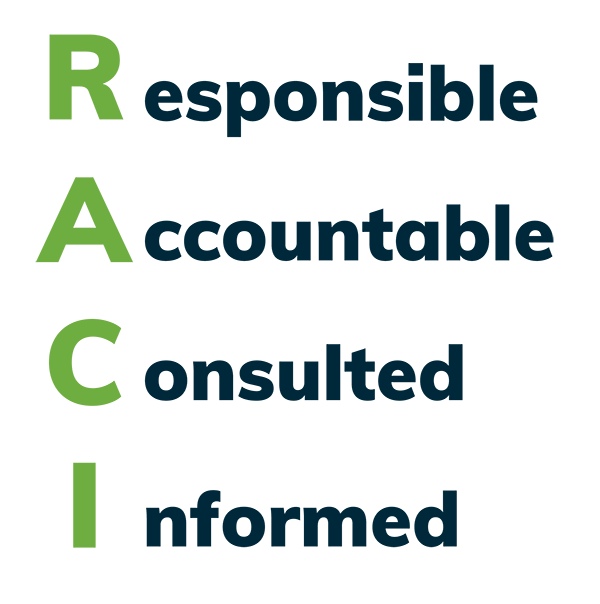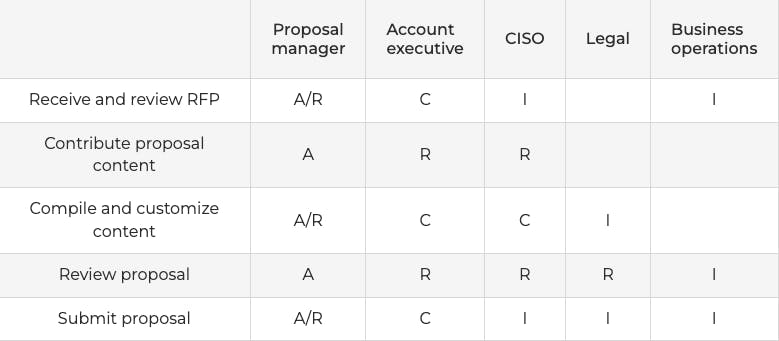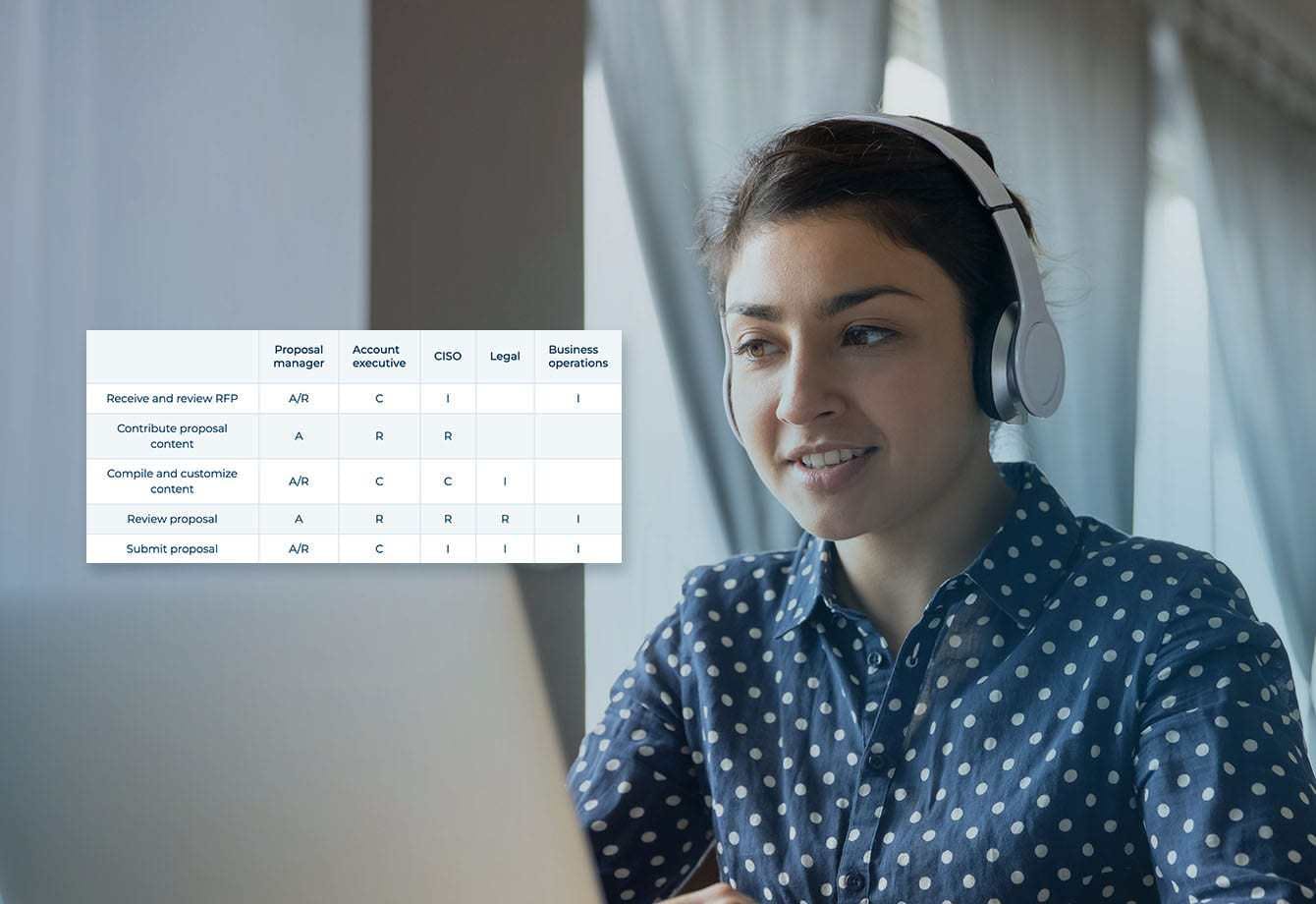Over my career in software, I’ve participated in a lot of projects from large-scale rebrands and implementations to relatively minor version releases. Some of these projects have gone poorly, and some have been seamless and successful. Regardless of the scope of the project and my role in it, I’ve noticed that many that have been successful have used a RACI matrix.
It organizes the team and keeps projects on track. It’s incredibly beneficial when responding to RFPs, security questionnaires and due diligence questionnaires. Indeed, it ensures that everyone involved in the response is on the same page from beginning to end. In this post, I’ll provide an overview of the RACI matrix, the basic steps to get started, a RACI matrix template and some pitfalls to watch out for along the way.Table of Contents:
- What is a RACI matrix?
- How to create a RACI project management matrix
- Should you use a RACI chart for project management?
What is a RACI matrix?
A RACI matrix (sometimes called a RACI chart, RACI diagram or RACI model) is a project management tool designed to clarify team roles and responsibilities in a project. It outlines who is Responsible, Accountable, Consulted, and Informed for each task, ensuring clear communication and efficient project execution. By delineating these roles, the RACI matrix helps eliminate confusion and streamline decision-making processes, contributing to timely project completion.

Using a grid to create a RACI chart helps team members understand the project and players at a glance. A plan with a RACI diagram of project resources can help better forecast completion timelines. At the same time, it also eliminates confusion and delays caused by uncertainty about who should be doing what within the project. In the RFP process, the RACI matrix establishes who must be involved in which project life cycle stages, from subject matter experts to stakeholders.
RACI role definitions
Responsible (R)
The person or people who will do the work required to complete a task or make a decision. Most projects will require multiple people to be responsible for items and steps throughout the project.
Responsible role examples in RFP response process:
- A subject matter expert (SME) is the person responsible for creating new response content
- The salesperson may be responsible for tailoring proposal content to the client’s needs
Accountable (A)
The person who owns the work, reviews it and signs off when a task or decision is complete. When two consulted stakeholders have different opinions, the person who is accountable makes the final call. Each task should only have one person designated as accountable.
Accountable role examples in the RFP response process
- A proposal coordinator who receives the RFP from sales and facilitates its completion
- The salesperson who manages the proposal themselves and coordinates with SMEs
- A marketing team member who creates the proposal and works with other parties
- The business operations team member who works to complete the proposal and ensures it aligns with business goals
Consulted (C)
The person or people that need to provide input before a specific task is started or finalized. Each task or decision may require multiple people to be consulted. Outlining expectations for those needing consultation ensures they are ready to provide input and won’t create a bottleneck in your process.
Consulted role examples in the RFP process
- Legal team members may need to discuss compliance and contract details
- An IT team member or the CSIO can provide input about security or technical capabilities
- The finance team may need to offer insights about requested financial terms
Informed (I)
The person or people who should be in the loop and informed throughout the project. Their input is not needed on the task, but they do need to know the output and receive regular progress updates.
Informed role examples in the RFP process
- Executive stakeholders may need visibility to the sales and proposal process
- Business operations or finance may want regular status reports to create forecasts
Benefits of using a RACI matrix
It provides additional benefits beyond outlining the roles and responsibilities of those involved in the proposal process. When all stakeholders and participants involved agree to the roles before the project begins, it creates a quick reference point that helps keep your team aligned. It also increases the likelihood that your project will be on time, complete and successful. Another benefit is that including one in your onboarding information can help new employees quickly understand the structure and process. Surely with all these benefits, it’s worth a try.
How to create a RACI project management matrix
Once you have a clear idea of the different roles, you’re ready to implement the project management RACI matrix. Here are the basic steps to follow.
- Identify all the tasks and decisions you need to complete.
- List out everyone who will participate in the project.
- Create your matrix. Typically, the number of tasks and decisions will be greater than the number of people participating in the project. If this is the case, you’ll want to list your tasks in the rows of the Excel chart and your involved people in the columns.
- Go through each task and assign roles. Make sure to only assign one A per task and at least one R, C and I.
- Socialize your matrix with your stakeholders, incorporate their feedback and finalize the project plan. It is key to get sign-off from all stakeholders, making sure they fully understand roles and expectations.
RFP response RACI matrix example
Let’s see it in action. In this example, a software company is responding to an RFP. The proposal is being managed by a dedicated proposal manager. An account executive owns the client relationship. The CISO must contribute proposal content. To protect the business, the legal team must have visibility to the project. And finally, business operations must be aware of how the project contributes to business goals.

Note that every task has at least one A and one R, but not every role is involved in every step.
RFP response RACI matrix template
Creating the RACI matrix isn’t complicated, but it can help to start from a template. Here’s an RFP RACI matrix template you can download.
If you want to take your RACI matrix even further or implement it across a number of teams, check out Hubspot’s free tool.
5 potential pitfalls to watch for when using the RACI matrix:
1. Responsibility confusion
Even with the RACI diagram, there can still be some stakeholders that are either confused or don’t respect the boundaries of their roles. The most common confusion I’ve experienced is between the consulted and informed roles.
Nothing slows a project down more than someone who is designated as informed providing input as though they must be consulted. The best way to avoid this delay and conflict is to be very clear at the beginning of the project. Let each person know exactly what is expected from them and then remind them of their roles when sending out project updates.
2. Too many tiny tasks
While outlining tasks and being specific is important, including too many subtasks and dependencies in your RACI matrix can be counterproductive. If your task list is too granular, it can be hard to keep the attention of your stakeholders when reviewing the proposal for sign-off.
3. Information overload
With all the moving parts of a project — especially a big project — the RACI chart can be hard to follow. Group your tasks into project phases and your stakeholders into teams. This will keep your chart easy to digest and quick to consult throughout the project. Try adding color coding for an easy-t0-understand visual element.
4. Unbalanced workloads
The RACI matrix is not meant to be a one-man show. For instance, if one person manages too many Rs and As, they become overwhelmed. As a result, you may not get the necessary perspectives and the project may be derailed. Instead, spread the work out to the appropriate team members and help avoid a scenario where one or two people are putting in all the effort.
5. Too many opinions
If your discussions seem to go around in circles, your matrix may have too many Cs across the board. While consulting is necessary, if you consult multiple team members for every task or decision, you can easily get bogged down in unnecessary back and forth.
Think hard about who really needs to be consulted and ask yourself a few questions. Do they have knowledge that is crucial to this step of the project? Are they an expert in this particular area? Will the project be at risk if their advice is not considered? If you answer no to these questions, consider updating your matrix and changing these people to informed instead of consulted.
Should you use a RACI chart for project management?
So, can a RACI matrix ultimately improve your proposal process? If you’ve ever walked away from project kick-off or weekly stand-up not knowing who was doing what, or if your projects get behind because the wrong people get involved and the right people aren’t consulted, a proposal RACI matrix might be a good tool for you.
To create a more efficient process, you might consider Responsive RFP software. You’ll save hours over manual processes and make lives easier for those who are Responsible, Accountable, Consulted and Informed.

